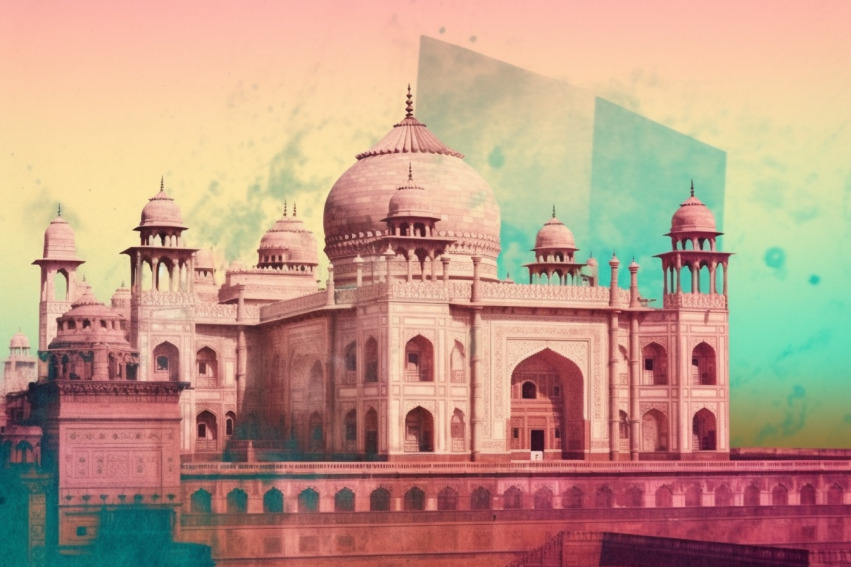You can find a PDF of this lesson plan here.
Lesson Overview
Featured article: Centers of Progress, Pt. 35: Agra (Architecture) by Chelsea Follett
In this article, Chelsea Follett writes, “Agra demonstrates the potential of intercultural borrowing and exchange. . . . In Agra, different cultures converged to create what many believe is humanity’s greatest architectural achievement: the Taj Mahal.” In this lesson, students will learn about the Mughal Empire and its rulers by exploring the theme of monumental architecture. They will also have the opportunity to research other “new wonders of the world” and examine their own beliefs about memorials in contemporary society.
Warm-up
Look closely at the photo of visitors to the Taj Mahal. Then discuss these questions as a class:
- What do you notice about this building?
- Where is it located?
- Why was it built?
- What materials were used in its construction?
- What is architectural syncretism?
- How is architectural syncretism represented in the Taj Mahal?
- Many architectural critics consider the Taj Mahal to be one of the most beautiful buildings in the world. Specifically, what makes its structure, materials, and layout so appealing?
- What is your reaction to this image?
Go to the entry about Agra in Encyclopedia Britannica. Spend some time exploring the article and images of Agra as a class, then discuss these questions:
- Where is Agra located?
- How far is it from India’s current capital, New Delhi?
- What two major empires in South Asia made their capitals at Agra for a time?
- Which famous rulers are associated with Agra?
- What was the religion of these rulers?
- What were the religions of the people of India at that time?
- During the early modern period, India was one of the wealthiest economies in the world. What economic factors were the foundation of India’s prosperity at the time?
Questions for reading, writing, and discussion
Read the article, then answer the following questions:
- Who was the founder of the Mughal Dynasty?
- What were some of the major achievements of Akbar the Great? List at least five.
- How are the multiculturalism and religious syncretism of Akbar and his descendants exemplified in the architecture of the Taj Mahal?
- What are aniconic designs? Why are such designs important in Islamic architecture and art?
- How is the use of white marble in the Taj Mahal reflective of Hindu architectural traditions?
- What is the connection between the pietra dura technique perfected during the Italian Renaissance and the jewel-inlaying technique of the Taj Mahal?
- How was Mumtaz Mahal’s number of children, their premature deaths, and her own passing during childbirth at the age of 38 illustrative of child mortality rates and rates of disease prior to the Industrial Revolution?
- In addition to their function as memorials to deceased rulers, what other purposes did the mausoleums at Agra serve? Specifically, how are they connected to political legitimacy?
- The materials used to build the Taj Mahal came from all over Afro-Eurasia. How does the sourcing of these materials exemplify India’s role in the economy of the region during the early modern period?
- Follett writes, “The building [of the Taj Mahal] is thought to have cost around 1 billion U.S. dollars.” What social, political, cultural, economic, and technological structures must have been in place in South Asia at the time for such an enormous tax revenue to be raised?
- Complete the chart below to synthesize important details about Agra’s architectural history:
| Architectural benefactor | Year/period | Associated architectural achievement(s) |
| Babur | ||
| Bega Begum | ||
| Akbar the Great | ||
| Jahangir | ||
| Shah Jahan | ||
| Aurangzeb |
Extension Activity/Homework
Write an Expository Essay
In the article, Chelsea Follett writes, “Much like the Renaissance paintings of Florence or the classical symphonies of Vienna, the Indo-Mughal architecture of Agra represents a high point of human achievement in the arts.” Indeed, in 2007 the Taj Mahal was selected as one of the New Seven Wonders of the World by more than 100 million people in an online vote.
Write an expository essay in which you respond to the following prompt:
How do the New Seven Wonders of the World demonstrate the artistic potential of intercultural borrowing and exchange?
Your essay should use detailed evidence about at least three of the seven “new wonders,” including their benefactor(s), designer(s), and original purpose and audience. Be sure to include information about how each structure syncretizes elements of diverse cultural and religious traditions.
Critique the Purpose of Memorials
Many of Agra’s architectural monuments are mausoleums of prominent leaders. These beautiful structures aim to preserve the memory of these individuals and inspire us through their artistic mastery. Their design and construction served to pass on knowledge and skills to new generations of engineers and artisans.
Create a persuasive presentation using PowerPoint or Google Slides in which you answer the questions below:
- What is the purpose of a public memorial in the 21st century?
- Is it still appropriate to build public memorials and monuments for prominent individuals? Why or why not?
- Is it more fitting to contemporary society that such structures be created for groups? Why or why not?
- Which types of individuals and/or groups should be memorialized in a public monument?
Profile ten prominent contemporary memorials and provide your opinion about their design, artistic merits, and effectiveness. Examples may include the Martin Luther King, Jr. Memorial in Washington, DC, the 9/11 Memorial & Museum in New York, the Tjentiste War Memorial in Bosnia and Herzegovina, and the Choeung Ek in Cambodia, among others. Argue your point of view. Include images and detailed information to back up your claims.

